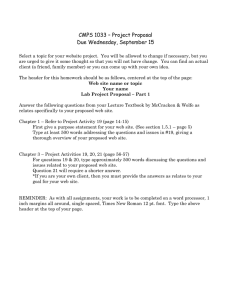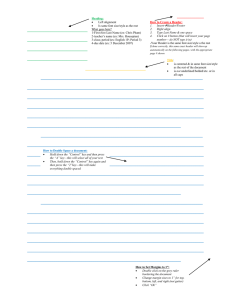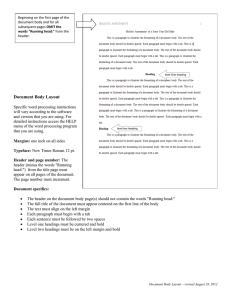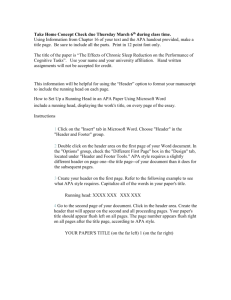Your header 1 Your Title Goes Here John Q. Student
advertisement
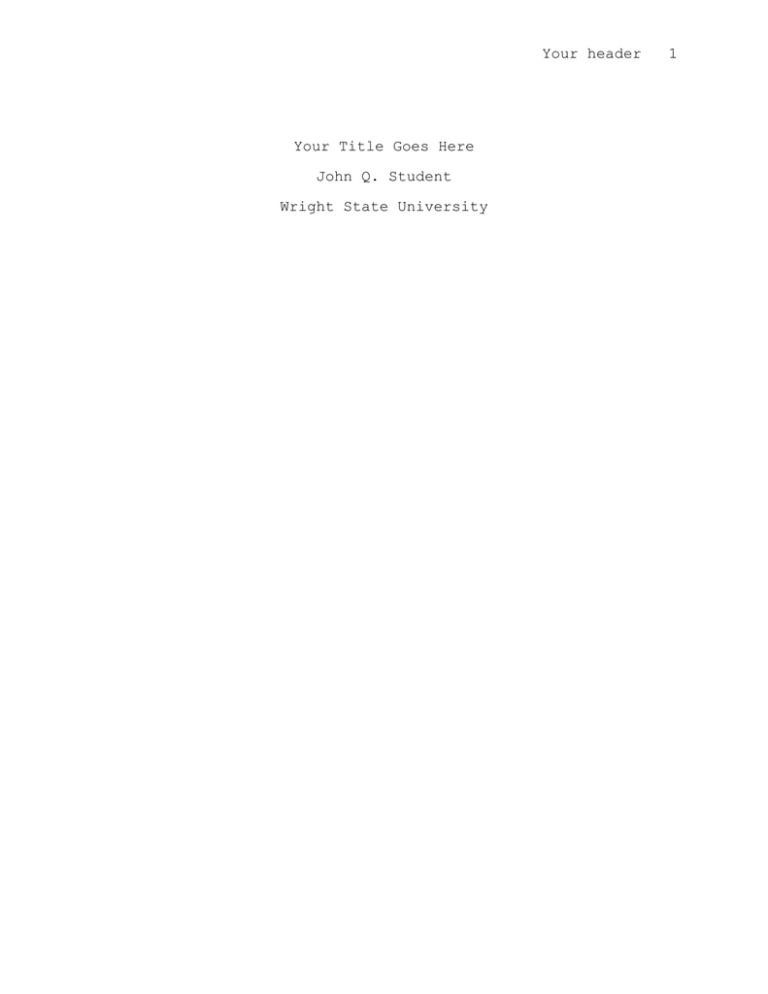
Your header Your Title Goes Here John Q. Student Wright State University 1 Your header 2 Error! No table of contents entries found. Table 1 APA Page Specs...................................................... 7 Figure 1 Opening the Door................................................... 5 Your header Abstract The abstract succinctly introduces the paper. We advise that it should not exceed 250–300 words. The abstract is conceptually divided into three sections. Background: include here a statement of the main research question. Methodology/Principal Findings. include here the techniques used without going into methodological detail, together with a summary of the most important findings with key numerical results given, with measures of error and not just p values. Conclusions/Significance: concisely summarize the study’s implications. Please do not include any citations in the abstract. Avoid specialist abbreviations if possible. 3 Your header Introduction The introduction should put the focus of the manuscript into a broader context. As you compose the introduction, think of readers who are not experts in this field. Include a brief review of the key literature. If there are relevant controversies or disagreements in the field, they should be mentioned so that a non-expert reader can delve into these issues further. The introduction should conclude with a brief statement of the overall aim of the experiments and a comment about whether that aim was achieved. 4 Your header Results The results section should provide details of all of the experiments that are required to support the conclusions of the paper. There is no specific word limit for this section. Figure 1 Opening the Door The section may be divided into subsections, each with a concise subheading. Large datasets, including raw data, should be submitted as supporting information files; these are published online alongside the accepted article. We advise that the results section be written in past tense. <Insert figure 2 in this area> 5 Your header Discussion The discussion should spell out the major conclusions of the work along with some explanation or speculation on the significance of these conclusions. How do the conclusions affect the existing assumptions and models in the field? How can future research build on these observations? What are the key experiments that must be done? The discussion should be concise and tightly argued. Conclusions firmly established by the presented data, hypotheses supported by the presented data, and speculations suggested by the presented data should be clearly identified as such. The results and discussion may be combined into one section, if desired. 6 Your header Materials and Methods This section should provide enough detail to allow full replication of the study by suitably skilled investigators. Protocols for new methods should be included, but wellestablished protocols may simply be referenced. We encourage authors to submit, as separate supporting information files, detailed protocols for newer or less well-established methods. These are published online only, but are linked to the article and are fully searchable. I suggest printing your document to make sure that your printer is properly configured to produce an APA page. It should produce no more than 27 lines per page, plus the header. The text block should be surrounded by 1" margins on all four sides. Each page should have a manuscript page header, not to be confused with the "running head" described in the APA Publication Manual (sec. 5.15). Page recommendations 1. Not more than 27 lines per page plus the header 2. 1 inch margins all around 3. Each page with a manuscript header Table 1 APA Page Specs The table title should be concise, no more than one sentence. The rest of the table legend and any footnotes should be placed 7 Your header below the table. Footnotes can be used to explain abbreviations. <Insert table 2 in this area> Tables must be no larger than one printed page (7inches x 9.5inches). Larger tables can be published as online supporting information. Bold and italics formatting will be preserved in the published version; however, more extensive formatting will be lost. Do not include color, shading, lines, rules, text boxes, tabs, returns, or pictures within the table. 8 Your header Acknowledgements People who contributed to the work but do not fit criteria for authorship should be listed in the Acknowledgments, along with their contributions. It is the authors’ responsibility to ensure that anyone named in the acknowledgments agrees to being so named. Details of the funding sources that have supported the work should be confined to the funding declaration provided on submission. Do not include them in the acknowledgments. 9 Your header References Doe, J. Q. (1999, 12 August). Title of an article. Title of a Magazine, 212, 23. Doe, J. R. (1987). Title of an article. Title of a Scholarly Journal, 35, 112-128. Lastname, F. (1998). Title of a sample book. City: Publisher. Maner, M. (1999, 14 April). Women and eighteenth-century literature. Retrieved August 9, 1999 from the World Wide Web: http://www.wright.edu/~martin.maner/18cwom99.html 10
